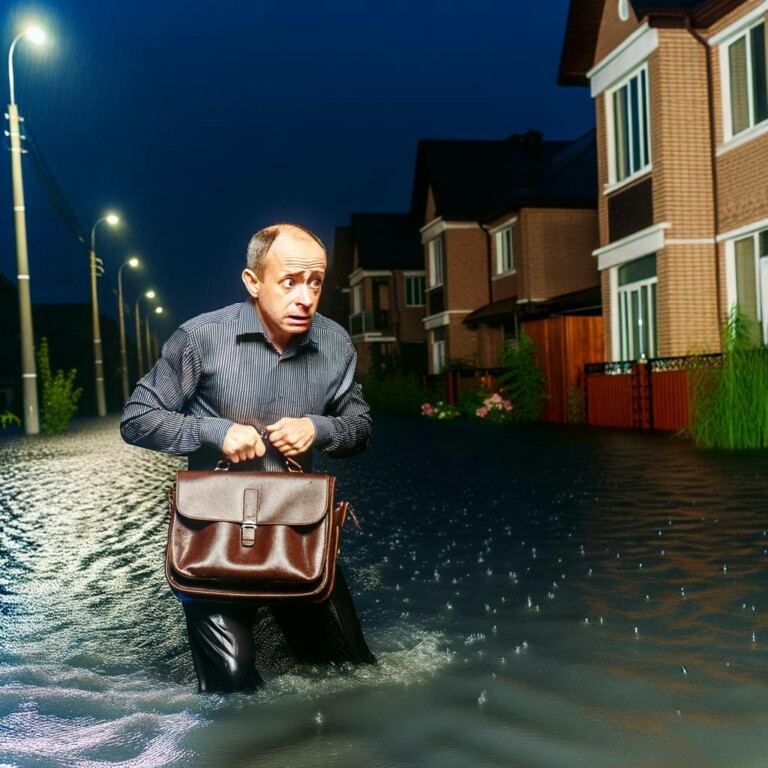The Impact of Sea Level Rise and Climate Change on Flood Risks in Savannah, GA
As climate change continues to reshape weather patterns globally, coastal regions like Savannah, Georgia, face growing challenges. Rising sea levels, increased frequency and intensity of storms, and shifting weather patterns are combined to create significant flood risks, particularly in vulnerable areas. Understanding these risks and taking proactive measures to mitigate them is crucial for Savannah’s future.
The Growing Threat of Sea Level Rise in Coastal Georgia
The state of Georgia faces a growing threat from sea level rise, as highlighted in a recent report by the university studying the impact of storms and sea level rise on its coastal regions. With over 20 percent of its population living in coastal areas, the need for effective solutions is urgent. Experts suggest a multifaceted approach that includes collaboration between government agencies, local citizen groups, and universities to promote awareness and adaptability to coastal hazards.
To implement this strategy, the service aims to enhance the capacity of communities through technical assistance and online resources. This initiative seeks to address both the human and ecological dimensions of land use planning, ensuring that diverse needs are met while safeguarding natural habitats. The purpose of such a comprehensive plan is to create a smarter, more resilient coastal Georgia that can withstand the threats posed by rising waters while fostering social and economic progress.
How Climate Change is Affecting Savannah Georgia’s Coastline
Savannah’s geographic location along the Georgia coast makes it particularly vulnerable to the impacts of climate change. As global temperatures rise, sea levels are increasing, leading to more frequent and severe coastal flooding. Local climate trends in Savannah are showing a gradual but steady rise in sea levels, which, combined with the area’s low-lying topography, puts the city at significant risk.
In addition to rising sea levels, climate change is driving changes in storm patterns. Coastal storms, including hurricanes, are becoming more frequent and intense. These storms bring heavy rainfall, storm surges, and strong winds, all of which can cause severe flooding and erosion along Savannah’s coast. As these storms become more powerful, the risk of damage to homes, businesses, and infrastructure in coastal areas like Savannah increases.
The Vulnerability of Savannah and Other Coastal Areas
Savannah’s vulnerability to flooding is not only due to its location but also its unique geographic and environmental characteristics. The city is surrounded by rivers, marshes, and the Atlantic Ocean, creating a complex hydrological environment that is highly susceptible to flooding. The Savannah River, in particular, plays a significant role in the city’s flood risk, with tidal influences and storm surges contributing to the potential for flooding.
Other coastal areas in Georgia face similar challenges. Communities along the coast, including Brunswick and St. Simons Island, are also experiencing the impacts of rising sea levels and increased storm activity. These areas share similar geographic characteristics with Savannah, making them equally vulnerable to the effects of climate change.
Coastal Erosion: A Major Concern for Savannah
Coastal erosion is another critical issue for Savannah and its surrounding areas. The combination of rising sea levels and increased storm activity accelerates the erosion of beaches and shorelines, threatening both natural and human-made structures.
Erosion hotspots, such as Tybee Island, are particularly at risk. Tybee Island, a popular tourist destination near Savannah, has experienced significant erosion in recent years, leading to the loss of valuable beachfront and increased flood risk for properties near the shore.
I have a personal connection to Tybee Island. Growing up, I spent my summers on the island, enjoying the beaches and the natural beauty it offered. One of the most memorable features of Tybee Island was its infamous dunes. These dunes weren’t just picturesque—they played a crucial role in protecting the beach from erosion. The dunes acted as natural barriers, absorbing the energy of waves and storm surges, which helped to prevent the sand from being washed away and protected the inland areas from flooding.
Over the years, however, I’ve witnessed the challenges that Tybee Island faces as climate change accelerates coastal erosion. The sand dunes that once stood tall are constantly under threat, and efforts to maintain them have become increasingly important.
For example, after recent hurricanes, Tybee Island had to undertake a beach renourishment project, bringing in sand to replenish the eroded beaches. This project was essential in preserving the island’s natural defenses, but it also highlighted the ongoing battle against coastal erosion that communities like Tybee Island are facing.
Coastal erosion not only affects the natural landscape but also has economic implications for Savannah and the surrounding region. Tourism, a major economic driver for the area, is directly impacted by the health of the beaches and coastal ecosystems. As erosion continues to threaten these assets, the local economy could suffer significant losses.
Assessing the Flood Risks in Savannah
Assessing the flood risks in Savannah requires a smart approach that takes into account various environmental factors. Experts often ask critical questions about the area’s geography and climate patterns to determine the potential for flooding. In this regard, it’s essential to analyze data from previous flood events and consider how climate change may lead to greater risks in the future.
To effectively manage these risks, the community must find a way to implement proactive measures. This could include improving drainage systems, enhancing green spaces, and developing awareness programs for residents. By addressing these challenges head-on, Savannah can create a more resilient environment that safeguards its infrastructure and citizens against potential flooding.
Identifying High-Risk Zones and Vulnerable Structures
Certain areas within Savannah are more vulnerable to flooding due to their proximity to the coast and other bodies of water. High-risk zones include historic districts, urban neighborhoods, and areas along major rivers. These zones are characterized by low elevation, poor drainage, and proximity to water sources, making them particularly susceptible to flooding during storms or periods of heavy rainfall.
Historic Districts at Risk of Inundation
Savannah’s historic districts, such as the Landmark Historic District, are not only culturally significant but also highly vulnerable to flooding. These areas feature older buildings that may not have been constructed with modern flood protection measures. The combination of aging infrastructure and increasing flood risks poses a serious threat to the preservation of Savannah’s historic charm.
Urban and Coastal Areas Facing Increased Flooding
Several neighborhoods in and around Savannah are already experiencing the impacts of climate change, including increased flooding. For example:
- Bradley Point Neighborhood: Located near the coast, this neighborhood is at growing risk from coastal flooding and storm surges. The combination of sea level rise and the increasing intensity of storms makes Bradley Point particularly vulnerable.
- Richmond Hill: While not directly threatened by sea level rise, Richmond Hill faces significant risks from changing weather patterns. Increased rainfall and shifting weather conditions have led to more frequent river flooding, particularly along the Ogeechee River, which runs through the area. This river flooding poses a serious threat to homes and infrastructure in Richmond Hill.
- Pooler: As one of Savannah’s rapidly growing suburban areas, Pooler faces inland flooding concerns. Urban expansion has led to increased runoff and reduced natural drainage, heightening the risk of flooding during heavy rainfall events.
- Garden City: Located in a low-lying area, Garden City is particularly vulnerable to heavy rainfall and flooding. The area’s low elevation and inadequate drainage infrastructure exacerbate flood risks, making it a hotspot for flood-related damage.
- Ogeechee River Areas: Communities along the Ogeechee River are experiencing severe flooding due to changing weather patterns. Increased rainfall and more intense storms are causing the river to overflow more frequently, leading to significant flood risks for homes and businesses in the region.
Spending my summers in Savannah and Tybee Island gave me a front-row seat to the changes that have taken place over the years. What used to be green spaces, such as the golf course at Hunter Army Airfield where I played with my grandfather, have now been developed into housing and roads. The trees and natural landscapes that once soaked up rainwater have been replaced with impervious surfaces, leading to more runoff and higher flood risks.
These changes are a stark reminder of how urbanization and development, while necessary, can exacerbate the impacts of climate change if not managed carefully.
Special Flood Hazard Areas (SFHAs) and Flood Zones
In Savannah, understanding your flood zone is crucial for assessing your flood risk and determining your insurance needs. The Federal Emergency Management Agency (FEMA) designates areas into different flood zones based on their level of risk:
- Flood Zone A: Areas with a 1% annual chance of flooding (often referred to as a 100-year floodplain). These are high-risk areas where no base flood elevations (BFEs) are determined. If you live in Flood Zone A, flood insurance is typically required if you have a mortgage.
- Flood Zone AE: Similar to Flood Zone A, but BFEs have been determined. These areas also have a 1% annual chance of flooding, and flood insurance is required for properties with a mortgage.
- Flood Zone V: Coastal areas with a 1% annual chance of flooding and an additional hazard of storm waves. These are high-risk areas, often along the coast, where flood insurance is mandatory for mortgage holders.
These zones, collectively referred to as Special Flood Hazard Areas (SFHAs), represent areas where the risk of flooding is significant. For homeowners in these zones, flood insurance through the National Flood Insurance Program (NFIP) is usually mandatory if they have a mortgage. Understanding your specific flood zone is critical to ensuring you have the appropriate coverage to protect your property from flood damage.
For areas outside of these SFHAs, known as Non-Special Flood Hazard Areas (NSFHAs), the flood risk is generally lower. However, flooding can still occur, and homeowners need to consider flood insurance even in these lower-risk zones.
Understanding Your Flood Insurance Options; Georgia Climate Impact
Given the changing flood risks in Savannah, homeowners need to understand their flood insurance options. Two primary options are available: the National Flood Insurance Program (NFIP) and private flood insurance. Both have their advantages, and understanding the differences between them can help homeowners make informed decisions.
National Flood Insurance Program (NFIP)
The NFIP is a federal program managed by FEMA, designed to reduce the financial impact of flooding on individuals and communities. Here’s an in-depth look at how the NFIP works and the coverages it offers:
- Coverage Limits: The NFIP provides flood insurance for both building structures and personal property. Residential properties can be insured for up to $250,000 for the structure and up to $100,000 for the contents. Businesses can secure coverage of up to $500,000 for both buildings and contents. However, these limits may not be sufficient for all properties, particularly in high-value areas where rebuilding costs can exceed these limits.
- Standardized Rates: The NFIP uses standardized rates based on your property’s flood zone, elevation relative to the base flood elevation (BFE), and the amount of coverage chosen. These rates are designed to be fair but might not fully reflect the actual flood risk for every property. Properties in high-risk areas like Flood Zones A, AE, and V typically face higher premiums, reflecting the increased risk of flooding.
- Eligibility and Participation: NFIP flood insurance is available to any homeowner, renter, or business owner in a community that participates in the NFIP. Over 22,000 communities nationwide participate in the program, including those in Savannah, Georgia. It’s important to note that while the NFIP is widely available, there is generally a 30-day waiting period before the policy takes effect, which means coverage isn’t immediate.
- Policy Structure: An NFIP policy is relatively straightforward, offering standard coverage options that include building property and personal contents. However, there are limitations—NFIP policies typically do not cover temporary living expenses if your home becomes uninhabitable due to flooding, or property outside the insured building, such as detached garages or swimming pools.
- Community Rating System (CRS): The NFIP also includes a Community Rating System (CRS) that rewards communities that exceed minimum floodplain management standards. Communities like Savannah can earn CRS points by taking measures to reduce flood risks, which can result in discounted flood insurance premiums for residents. This system incentivizes cities and towns to invest in flood prevention and preparedness.
Private Flood Insurance
Private flood insurance is offered by private insurance companies and provides an alternative to the NFIP. Here’s how private flood insurance differs from the NFIP:
- Higher Coverage Limits: One of the main advantages of private flood insurance is that it often offers higher coverage limits than the NFIP. This can be particularly beneficial for homeowners with high-value properties or businesses that need more extensive coverage. Some private insurers offer policies that cover up to $1 million or more for building property and contents, far exceeding the limits set by the NFIP.
- Flexible Policy Options: Private flood insurance policies tend to be more flexible than NFIP policies, allowing homeowners to tailor coverage to their specific needs. For instance, private policies might include additional living expenses, which cover the cost of temporary housing if you’re displaced by a flood, or they might offer coverage for outbuildings, landscaping, and pools.
- Customized Premiums: Unlike the NFIP’s standardized rates, private flood insurance premiums are often customized based on a more detailed assessment of your property’s flood risk. Private insurers use advanced modeling techniques to assess risk, which can result in lower premiums for properties that are less prone to flooding. However, in some high-risk areas, private insurance could be more expensive than the NFIP.
- Immediate Coverage: Another advantage of private flood insurance is that some policies can take effect almost immediately, without the 30-day waiting period required by the NFIP. This can be a critical factor for homeowners who need coverage quickly due to an impending storm or recent property purchase.
- Acceptance by Mortgage Lenders: Private flood insurance is accepted by most mortgage lenders, as long as the policy meets certain criteria set by federal guidelines. However, it’s always important to confirm with your lender that the private policy you choose complies with their requirements.
- Exclusions and Considerations: As with any insurance policy, it’s crucial to read the fine print. Private flood insurance policies may have different exclusions compared to NFIP policies, such as coverage limitations for basements or specific property types. Understanding these details can help you choose the right policy for your situation.
Comparing NFIP and Private Flood Insurance: Which is Right for You?
When deciding between NFIP and private flood insurance, Savannah homeowners should consider several factors:
- Location and Flood Risk: If you live in a high-risk flood zone, such as Zones A, AE, or V, and have a mortgage, you’re required by law to have flood insurance, which can be obtained through the NFIP or private insurers. For those in lower-risk areas, private flood insurance might offer more competitive rates or more comprehensive coverage options.
- Property Value: If your home or business is valued above the NFIP’s coverage limits, private flood insurance might be a better option because of its higher coverage limits. This is particularly important for properties in areas like historic Savannah, where rebuilding costs can be significant.
- Custom Needs: If you require additional coverage, such as protection for temporary living expenses, outbuildings, or personal property stored outside, private insurance may offer more flexibility to meet these needs.
- Cost Considerations: While NFIP rates are standardized, private flood insurance premiums are customized and may vary based on individual risk factors. Comparing quotes from both NFIP and private insurers can help you determine the most cost-effective option for your situation.
- Community Rating: If Savannah has a high Community Rating System score, residents might receive discounts on NFIP premiums, making it more competitive with private insurance.
- Waiting Period: If you need immediate coverage, private flood insurance could be advantageous due to its typically shorter or nonexistent waiting period.
For many Savannah homeowners, the decision will come down to a balance between cost and coverage. It’s important to review both NFIP and private flood insurance options carefully and consult with a knowledgeable insurance agent to make the best choice for your specific circumstances.
Using Flood Score to Understand and Manage Flood Risks
As flood risks in Savannah continue to evolve due to climate change and urban development, homeowners must stay informed about their property’s specific flood risk. This is where tools like the Flood Score come into play.
What is a Flood Score?
A Flood Score is a numerical rating that represents the flood risk of a specific property. It takes into account various factors such as the property’s elevation, proximity to water bodies, historical flood data, and changes in weather patterns. The Flood Score provides a clear, easy-to-understand measure of your property’s flood risk, helping you make informed decisions about flood insurance and risk management.
Flood Risk Tools
There are many flood risk tools to help you understand your flood risk score. You can use things like risk factor or the Flood Insurance Guru Flood Risk Tool.
How to Use Your Flood Score
Understanding your Flood Score can help you take proactive steps to protect your property from flood damage. Here’s how:
- Assess Insurance Needs: A higher Flood Score indicates a higher risk of flooding, which may necessitate more comprehensive flood insurance coverage. If your Flood Score is high, consider exploring both NFIP and private flood insurance options to ensure you have adequate protection.
- Evaluate Property Improvements: If your Flood Score reveals a significant risk, you might consider making improvements to your property to reduce that risk. This could include elevating your home, improving drainage systems, or installing flood barriers.
- Monitor Changes Over Time: Flood risks can change due to new developments, changes in weather patterns, or updates to flood maps. Regularly checking your Flood Score can help you stay informed about any changes in risk and adjust your insurance coverage accordingly.
- Plan for Emergencies: A high Flood Score should also prompt you to develop a robust emergency plan. This includes having an evacuation plan, keeping important documents safe, and knowing what to do before, during, and after a flood.
The Importance of Staying Informed for Resilience
Flood risks in Savannah are not static. As the climate continues to change, so too will the factors that contribute to flooding. By staying informed about your property’s flood risk, whether through a Flood Score or other means, you can better prepare for potential flooding events and protect your home and family.
For homeowners in Savannah, understanding the nuances of flood zones, insurance options, and flood risk management is more important than ever. Whether you’re relying on the National Flood Insurance Program, exploring private flood insurance options, or using tools like the Flood Score, the key is to be proactive in protecting your property from the ever-present threat of flooding.
Conclusion: Preparing Savannah for Future Climate Challenges
Savannah, Georgia, is a city steeped in history and rich in natural beauty, but it is also one that faces significant challenges due to climate change and the associated flood risks. As sea levels rise and weather patterns shift, the risks to Savannah’s homes, businesses, and infrastructure continue to grow.
By understanding your flood risk through tools like the Flood Score, and by carefully choosing the right flood insurance—whether through the NFIP or a private provider—you can protect your property and ensure that you’re prepared for whatever the future may bring. Additionally, staying informed about changes in flood zones and taking steps to mitigate risks, such as improving your property’s flood resilience, can make a significant difference.
As a community, Savannah must continue to invest in flood prevention and resilience measures. The preservation of natural barriers like Tybee Island’s dunes, the careful management of land development, and the participation in initiatives like the Community Rating System are all crucial steps in safeguarding the city’s future.
In the face of increasing challenges, the residents of Savannah can take comfort in knowing that there are tools, resources, and strategies available to help them navigate the complexities of flood risk. By taking action today, we can build a more resilient Savannah, ready to face the climate challenges of tomorrow.
Information contained on this page is provided by an independent third-party content provider. This website make no warranties or representations in connection therewith. If you are affiliated with this page and would like it removed please contact editor @producerpress.com


.png?width=1280&height=720&name=NEW%20Thumbnail%20(10).png)











